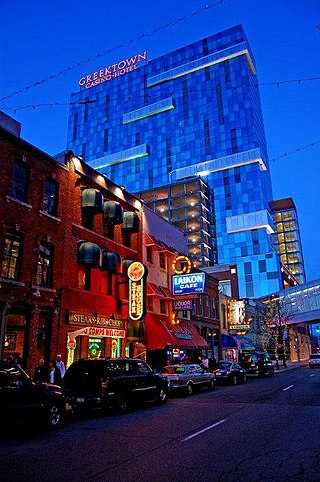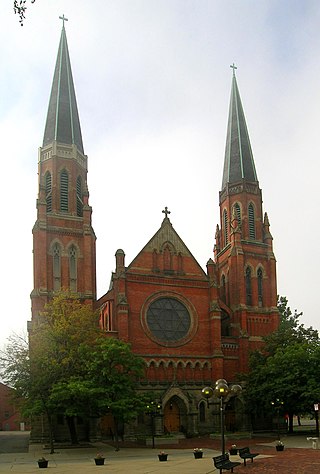Aspect of history
| Part of a series on |
| Ethnicity in Metro Detroit |
|---|
In 2004 58.5% of the people of Hispanic origin in the Wayne County-Macomb County-Oakland County tri-county area were Mexicans. [1]
| Part of a series on |
| Ethnicity in Metro Detroit |
|---|
| Part of a series on |
| Chicanos and Mexican Americans |
|---|
In 2004 58.5% of the people of Hispanic origin in the Wayne County-Macomb County-Oakland County tri-county area were Mexicans. [1]
In 1910 the State of Michigan had fewer than 100 Mexicans. [2] In the 20th century the original Mexicans arriving in Detroit came from the central portion of Mexico. Mexicans moved to Detroit to get industrial jobs, including Henry Ford's $5 per day jobs. The community of Mexicantown, originally known as "La Bagley", was established to provide Mexican-oriented goods and services. [3] Historians estimated that in reality Detroit alone had over 4,000 Mexicans even though the U.S. census of 1920 only counted 1,268 Mexicans in the entire state. [4]
In 1951 in Detroit there were about 15,000 to 17,000 U.S.-born ethnic Mexicans and 12,000 Mexican-born residents. [5]
Around the 1950s/1960s, the second generation and third generation of Mexicans had been born in Michigan and their presence caused the size of the Metro Detroit Mexican community to increase. [6]
In 2014 there were 22,700 Mexican immigrants in Wayne County, making Mexicans the largest immigrant group in that county. Within Metro Detroit overall, Mexicans are the third-largest immigrant group. In Macomb and Oakland counties, the Mexican populations are among the ten largest immigrant groups in each county. [7]
Around the 1950s and 1960s large numbers of second and third generation ethnic Mexicans worked in steel foundries, steel factories, and automotive plants. [6]
Jose R. Flores founded El Informador in 1954. It closed in 1956. After the end of El Informador, Jose Flores bought El Atomo. He changed its name to Noticias ("News"). In 1958 a Monterrey-originating teacher, Jose Elisandro, established Ecos de Michigan ("Echoes from Michigan"). Noticias closed at the time Ecos opened. Six months later, El Heraldo ("The Herald") opened and Ecos closed. El Heraldo closed in 1961. [6]
Beginning in 1961, [6] when there were no Michigan-based Spanish language newspapers, area Mexicans read Spanish language newspapers from other states. They included El Diaro, Excelsior, El Informador, Iniversal, El Norte , Novedades , La Opinión , and La Prensa . [8]
Several mutual aid societies historically served the Mexican community. Among them were the Los Caballeros Catolicos and the VFW Mexican American Post #505. In 1960 the youth group Club Camellia was founded. In 1961 the Comite de Festejos Guadalupanos ("Committee of Guadalupe Parties") was founded. [8]

Mexicans and Mexican Americans began attending Holy Redeemer Catholic Church in Mexicantown in 1955. In 1955 the Primera Iglesia Bautista Mexicana ("First Baptist Mexican Church") opened and its membership was 200 families by 1960. The same congregation established a branch of the Lincoln Park Baptist Church, the Primera Iglesia Bautista del Sur (First Baptist Church of the South) that year. By 1960, the Holy Redeemer Elementary School had 200 Mexicans out of its 1,200 students. By 1961 the Holy Redeemer church had established a Spanish-language mass and it had 500 Mexican church worshipers. [6]
As of the 1950s and 1960s other churches frequented by Mexican Americans and Mexicans included All Saints Church, Holy Cross Church in Delray, Most Holy Trinity, St. Anne's, St. Anthony, St. Boniface, St. Leo, and St. Vincent. [6]
There was a Mexican radio hour in Detroit. [9] Javier Cardenas, a native of Guadalajara who worked for WPON , started a Spanish-language radio program which began airing in October 1952. Every Saturday and Sunday it aired for one hour each. The program switched to WPAG in January 1955. In 1958 it switched to WHRV . Cardenas began directing and producing a Sunday-only program, airing from 10:00 AM to 11:30 AM, for WQTE in 1961. In 1980 the radio program on WQTE stopped airing. [8]
Dancing and music groups included "Club Fiesta," "Most Holy Trinity Dancing Club" and "Club Artistico Pemamino". At that time there were no sporting clubs. [9]
The Alamo Theater, the first Spanish language movie theater, opened in 1961. [8]

Macomb County is a county located in the eastern portion of the U.S. state of Michigan, bordering Lake St. Clair, and is part of northern Metro Detroit. As of the 2020 Census, the population was 881,217, making it the third-most populous county in the state. The county seat is Mt. Clemens. Macomb County is part of the Detroit-Warren-Dearborn, MI Metropolitan Statistical Area. The city of Detroit is located south of the county's southern border. Macomb County contains 27 cities, townships and villages, including three of the top ten most-populous municipalities in Michigan as of the 2010 census: Warren (#3), Sterling Heights (#4) and Clinton Township (#10). Most of this population is concentrated south of Hall Road (M-59), one of the county's main thoroughfares.

Corktown is a neighborhood located in Detroit, Michigan. It is the oldest extant neighborhood in the city. The current boundaries of the district include I-75 to the north, the Lodge Freeway to the east, Bagley and Porter streets to the south, and Rosa Parks Boulevard to the west. The neighborhood was listed on the National Register of Historic Places in 1978.

Mexicantown is a neighborhood located in Detroit, Michigan.
The culture of Detroit, Michigan, has influenced American and global culture through its commercial enterprises and various forms of popular music throughout the 20th and 21st century. Its automotive heritage plays an important role in the city's culture.

Holy Redeemer High School was a Roman Catholic secondary school located in Southwest Detroit, at the corner of Junction and Vernor streets, near the Ambassador Bridge to Canada. It was overseen by the Archdiocese of Detroit.

West Vernor–Junction Historic District is a commercial historic district located along West Vernor Highway between Lansing and Cavalry in Detroit, Michigan. The district includes 160 acres (0.65 km2) and 44 buildings. The district was listed on the National Register of Historic Places in 2002.

The Most Holy Redeemer Church is located at 1721 Junction Street in Southwest Detroit, Michigan, within the West Vernor–Junction Historic District. The church was once estimated as the largest Roman Catholic parish in North America. West Vernor–Junction Historic District is adjacent to Mexicantown and contains a growing Mexican community and resurgent neighborhood.

The city of Houston has significant populations of Mexican Americans, Mexican immigrants, and Mexican citizen expatriates. Houston residents of Mexican origin make up the oldest Hispanic ethnic group in Houston, and Jessi Elana Aaron and José Esteban Hernández, authors of "Quantitative evidence for contact-induced accommodation: Shifts in /s/ reduction patterns in Salvadoran Spanish in Houston," referring to another large Latino group in Houston, stated that as of 2007 it was the most "well-established" Hispanophone ethnic group there. Houston is the third city for Mexican immigrants after Chicago and Los Angeles.
As of the census of 2010, there were 5,196,250 people, 1,682,111 households, and 1,110,454 families residing within the Detroit–Warren–Ann Arbor Combined Statistical Area. Within the Detroit–Warren–Dearborn Metropolitan Statistical Area, there were 4,296,250 people residing. The census reported 70.1% White, 22.8% African-American, 0.3% Native American, 3.3% Asian, 0.02% Pacific Islander, 1.2% from other races, and 2.2% from two or more races. Hispanic or Latino of any race were 6.2% of the population. Arab Americans were at least 4.7% of the region's population.

In 2004, Metro Detroit had one of the largest settlements of Middle Eastern people, including Arabs and Chaldo-Assyrians in the United States. As of 2007 about 300,000 people in Southeast Michigan traced their descent from the Middle East. Dearborn's sizeable Arab community consists largely of Lebanese people who immigrated for jobs in the auto industry in the 1920s, and of more recent Yemenis and Iraqis. In 2010 the four Metro Detroit counties had at least 200,000 people of Middle Eastern origin. Bobby Ghosh of TIME said that some estimates gave much larger numbers. From 1990 to 2000 the percentage of people speaking Arabic in the home increased by 106% in Wayne County, 99.5% in Macomb County, and 41% in Oakland County.
In 2002, there were 6,413 people of Japanese origin, including Japanese citizens and Japanese Americans, in the Wayne-Oakland-Macomb tri-county area in Metro Detroit, making them the fifth-largest Asian ethnic group there. In that year, within an area stretching from Sterling Heights to Canton Township in the shape of a crescent, most of the ethnic Japanese lived in the center. In 2002, the largest populations of ethnic Japanese people were located in Novi and West Bloomfield Township. In April 2013, the largest Japanese national population in the State of Michigan was in Novi, with 2,666 Japanese residents. West Bloomfield had the third-largest Japanese population and Farmington Hills had the fourth largest Japanese population.
As of 2002, ethnic Chinese and Chinese American people comprise the second-largest Asian-origin ethnic group in the Wayne–Macomb–Oakland tri-county area in Metro Detroit. As of that year there were 16,829 ethnic Chinese, concentrated mainly in Troy, Rochester Hills, and Canton Township. As of 2012, Madison Heights also hosts a significant Chinese community.
The Hungarian people and Hungarian Americans immigrated to Metro Detroit in the 20th century. Historically they populated Delray in Detroit but moved to the Downriver area in the 1960s. There were four historic waves of Hungarian immigration to Detroit.

As of 2001, the Metro Detroit area had the U.S.'s second largest Polish ethnic concentration after Chicago. As a whole, Michigan has the second-largest percentage of Polish ancestry of any U.S. state.
The National Italian American Foundation estimated that in 1990, Metro Detroit had 280,000 ethnic Italians.
A 2013 report by the Global Detroit and Data Driven Detroit stated that of the immigrant ethnic groups to Metro Detroit, the largest segment is the Indian population. As of 2012, the Indian populations of Farmington Hills and Troy are among the twenty largest Indian communities in the United States. As of the 2000 U.S. Census there were 39,527 people with origins from post-partition India in Metro Detroit, making them the largest Asian ethnic group in the Wayne County-Macomb County-Oakland County tri-county area. People of those origins are found throughout Metro Detroit, with the majority being in Oakland County.

As of 1999 120,000 people in Metro Detroit indicated they are of Greek descent. Stavros K. Frangos, author of Greeks in Michigan, stated "From the 1890s to the present all available sources agree that" about one third of Michigan's Greek Americans live in Metro Detroit.

Metro Detroit has the following ethnic groups:

Metro Detroit includes Christian, Muslim, Jewish, Hindu, Buddhist, and other groups.
The organization Global Detroit stated that the largest group of ethnic Albanians not in Europe is in Metro Detroit. As of 2014, 4,800 ethnic Albanians live in Macomb County, making up the fourth-largest ethnic group in that county, and the highest concentration of Albanians in Metro Detroit.